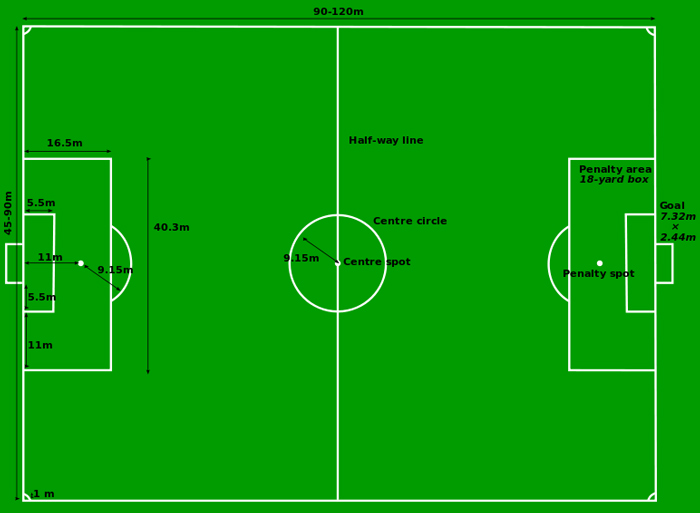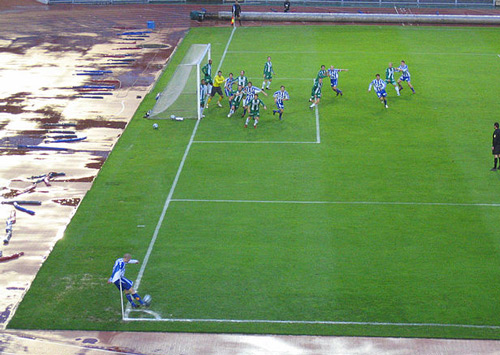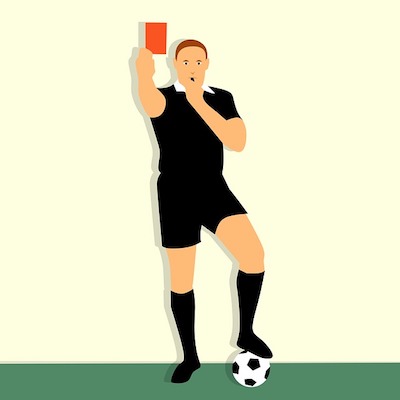
Interested in playing soccer but don’t know where to start? Don’t worry, in today’s article we explain how to play soccer, as well as answer some of the most commonly asked questions about the popular sport.

Without question the most deeply impactful, widely followed and feverishly cheered-on sport in the world, soccer (or football as many fans prefer it to be called) is unmistakably gaining traction in the United States as well.
If the last World Cup was anything to go by, there’s an ever-increasing number of dedicated fans who embrace it with a passion any Brazilian or German fan would understand and expect.
With another World Cup about to kick off shortly, it’s a fantastic time to get involved. There’s nothing quite like being swept away by the chanting, the colors and rollercoaster of emotions that accompany each match. From 5th league matches between villages in Bulgaria to the world’s finest teams squaring off against each other, soccer has the power to make people come together and share moments of rivalry, camaraderie and incredible passion.
But, first you need to have a basic grasp of how soccer is played. There are so many nuances to the sport that even successful coaches with legendary track records can still be awed by players’ ingenuity. On the other hand the basic rules are very beginner-friendly, so anyone who reads this guide can start watching their first match right away with both interest and understanding.
This is the SkillSpeedPower.com guide to soccer for beginner’s.
Some of the links below are affiliate links, meaning, at no additional cost to you, we may make a commission if you click through and make a purchase.
When was soccer invented?
It’s impossible to tell when exactly the thought of trying to shoot a round object through a set of poles or similar markers occurred to humans. We know that crude variations of what was to become soccer were played in Rome, China, Australia and the Americas. Of course, these were games with different rules and the use of arms wasn’t forbidden in all of them, but they certainly had the right idea literally thousands of years before association football came into existence.
https://www.youtube.com/watch?v=mewi5hIrzuM
If we’re talking about the consolidation of soccer into a sport we can track, then the answer is that soccer was ‘invented’ in 1863 by the formation of the Football Association. The FA is the governing body for soccer in England and Wales and is actually still going strong right to this day.
It is an organization whose goal it was to refine rules that had been in the making in Cambridge (a small city in England) since the early 1800s and combine them with the rules that informal matches around the country had used, to come up with a single set of regulations everyone could follow and agree on.
- The oldest surviving independent soccer club is Sheffield F.C. from Sheffield, England. They were founded in 1857.
- The first official international soccer match was in 1872. It was between Scotland and England in Glasgow. it finished 0-0 and was watched by around 4,000 fans.
- The oldest soccer competition in the world is the FA Cup. Wanderers won the inaugural trophy in 1872. The FA Cup is still contested in England to this day.
How long is a soccer game?
Officially, one soccer game takes 90 minutes to play.
However, additional time is almost always added. This is called ‘injury time’ and accounts for times during the game where play was stopped. It usually lasts from 1-5 minutes but on occasion can last longer.
In the later stages of cup competitions, the 90 minutes can be extended into what is called ‘extra time’. This happens when a game has been tied and a winner must be decided upon on the day. Extra time usually comes into play from the 1/4 finals onwards of most major cup competitions, but each competition has its own rules.
Extra time involves an additional 30 minutes of game time. This is split into two halves.
After extra time, if the game is still tied then a penalty shootout takes place.
How long is halftime in soccer?
Halftime is 15 minutes in a game of professional soccer.
How big is a soccer field?
Not all soccer fields (pitches) are the same size, but their dimensions must lie between strict boundaries.

The length of a pitch has to be between 100 – 130 yards (90 -120m).
The width of the pitch must be between 50 – 100 yards (45 – 90m).
The large box that encompasses each goal is called the penalty box or the 18-yard box. The smaller box inside it is called the 6-yard box. I don’t think we need to tell you how big they are.
The goal itself should measure 8 feet in height (2.44m) and 8 yards wide (7.32m).
Different league associations or cup competitions might have their own variations of the size limits where they make the range of sizes smaller.
In the last English Premier League season (2017/2018), Brighton had the largest pitch. It measured 105m x 69m to give an overall area of 7,245m2
Stoke City had the smallest pitch. It measured 100m x 64m for an overall area of 6,400m2
How much does a soccer ball weigh?
As with the field’s dimensions, soccer balls needed to be standardized so that conditions for professional players around the world are as equal as possible. As children would have a hard time playing with a regulation soccer ball, FIFA has introduced five ball sizes, the biggest of which is also the sport’s official one.
A size five ball (this is the type used in the professional game) weighs between 420 and 450 grams (14-16 ounces) and has a circumference of 27-28 inches.
How many players are there?
A standard team on the field has 11 players. They all have consecutively numbered jerseys and have specialized roles to play. Each team has a number of reserve players (substitutes) who can jump in if a player on the field is injured or is too tired to carry on effectively.
How many players on a soccer team get to play in a match depends on the number of substitutions their coach makes. Usually three substitutions can be used, increasing the potential number of participating players to 14. When going off to the World Cup, each national team numbers 23 players. But, only 11 are allowed on the field at once.
What are their roles?
Each soccer player has a given role which is determined by his position on the playing field. Although some roles are more flexible than others, a soccer team’s players generally specialize in performing one of four functions – goalkeeping, defending, ball possession and striking.
The goalkeeper is each team’s last line of defense against their opponents’ onslaught. Equipped with lightning reflexes, a differently colored kit and a snazzy pair of gloves, he’s the only one who can touch the ball with his hands (but only within his 18-yard box). He needs to keep a keen eye on the ball and position himself properly to meet it. Although goalkeepers usually stay well within the goal and penalty boxes, a few have been known to sometimes rush forward and help their team press the attack.
https://www.youtube.com/watch?v=IvT2o7gDrbQ
Defenders are there to make sure that the goalkeeper has as little to do as possible. Rarely venturing out from their side of the field, defenders take every chance they get to harass opposition players, thwart their passes and take away possession of the ball from them as soon as their domain is under attack. They don’t need to run as much as midfielders and forwards in an even match, but do have to strategically think on their feet, preventing opposing players from sneaking up from the flank, intercepting dangerous passes and getting the ball out of harm’s way as quickly as possible.
Midfielders are the most versatile players on each team. They occupy the middle third of the field, serving as the connecting line between the team’s defending and attacking players. They’re responsible for setting up goal opportunities, stopping the other team’s advance before it can develop into a full-blown attack and make sure that their team is in possession of the ball as much as possible. Often referred to as playmakers, their skill at anticipating the opposing players’ moves and exploiting them makes good midfielders invaluable, and the best ones god-like.
Forwards bring the fight to the opposing team, staying in the latter’s half of the field most of the time. While their highest duty is to rattle the net to fans’ roaring satisfaction, there’s much more to forwards than opportunism. A good forward doesn’t only score goals – he sets the play up so that other teammates have a chance to. Notorious for their superior reactions and shooting abilities, the best forwards run rings around defenders, draw their attention from other players and work in unison in a way that borders on art itself.
What is a corner kick?
A corner kick happens when a player of the defending team sends the ball past the goal line, but not into the actual goal. It is a form of penalty designed to keep defenders from putting the ball out of play while offering attackers both a respite and a good chance at scoring a goal. The player who executes the corner kick takes up a position and places the ball on the corner ark. He can then attempt to kick it into the goal directly, but most choose to kick it towards their teammates who have a better angle and chance of landing the shot.

What is an offside offence?
One of soccer’s most-known yet trickiest rules, is the offside rule. It happens when an attacking player is closer to the opposition goal line than any outfield opposition player (the goalkeeper doesn’t count), at the moment when the ball is passed to him/her.
So, if there’s no opposition player between him/her and the goal (other than the goalkeeper) and the ball is played forward to this player, then they are offside. When this happens a free kick is given to the defending team. It is taken from where the offside player was standing.
To bypass the offside rule, attacking players must time their forward runs so that there is still a defending player between them and the goal at the moment the ball is passed.
This video explains it all really well.
Who keeps players in line?
Each official soccer match is carefully watched over by a referee and two linesmen (and sometimes a fourth official). Their job is to run alongside the players, staying close to the action but never interfering, and to observe the game’s rules.
There’s one main referee who has to be very fit as they have to follow the game on the pitch. But since he can’t possibly see every offside call closely, he has two assistant referees who help out.
These two assistants are called linesmen. Each covers one half of the length of the pitch. They run up and down the pitch to help the referee with offside decisions and whether the ball has gone out of play or not. They also assist the referee with any big decisions as they may have had a better view of the incident.
In most professional games these day there is also a fourth official. They aren’t involved with the actual gameplay but instead officiate things on the touchline. They oversee substitutions and timekeeping, as well as making sure the managers are behaving themselves.
Each nation’s national association appoints referees who then judge official major league matches. To ensure impartiality during international matchups, referees from other countries are invited.
What is a red card in soccer?
Unsportsmanlike behavior is something referees are there to prevent and will not tolerate. While a little jostling and maneuvering is considered fair play, more serious offenses may result in penalties.

The milder one is called a yellow card and is given to players who don’t behave appropriately, keep the game from resuming or exit the field without getting the referee’s permission. A yellow card is like a warning. Two yellow cards makes a red card and that’s when things get really bad.
Red cards are the ultimate penalty, one which players shamefully receive when they get violent, spit on others, get another yellow card, commit terrible fouls or use their hand to keep the other team from scoring. Getting one results in an immediate ban from the current game and possibly the following ones too.
What is a hat trick in soccer?
The hat trick is a respectable feat that’s accomplished when one player manages to score three goals in the same match. He doesn’t need to score them in a row, but does need to do so during regular play time as penalty shootout goals don’t count towards the achievement.
What is a cap in soccer?
The ‘cap’ is both a term and an actual cap which signifies that a player has been chosen and accepted to play for his national team. Why a cap though? It is a British custom that lives on to this day to give special honorary caps out to players who have been chosen. They’re treasured possessions and wearing one is a point of pride, so the term stuck and got around.
If a player has 20 caps, it means he has played for his country 20 times.
Why is soccer also called football?
The game is mostly referred to as football outside of the US since the players primarily use their feet to get the ball where they need it to go. Some beautiful plays can be made with one’s body, and fans always appreciate a well-executed header – a shot performed using one’s head – but unless you’re the goalkeeper, using your hands to touch the ball in any way during the game is strictly forbidden.
The term ‘soccer’ comes from a slang word for the association part of association football that was used by Cambridge students in the 1800s.
What does FC stand for in soccer?
‘FC’ is the abbreviation you most often see in front of club names. It stands for ‘football club’ and its various iterations in other languages.
We hope you found our beginner’s guide to soccer useful. If you have any questions then let us know down in the comments section and we’ll get back to you promptly.
For other sports articles like this, we recommend our posts on unusual sports and the world’s biggest stadiums.
Images:
NielsF [GFDL, CC-BY-SA-3.0 or CC BY-SA 2.5], via Wikimedia Commons
By Johan Elisson – Taken from english wikipedia [1], CC BY-SA 3.0, Link
